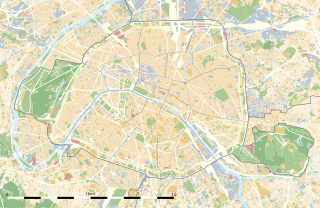
Goncourt is a station on line 11 of the Paris Métro in the 10th and 11th arrondissements. It is named after the nearby rue des Goncourt, which was named after the writers Edmond de Goncourt (1822–1896) and his brother Jules de Goncourt (1830–1870). Edmond de Goncourt left funds to create the Académie Goncourt which awards the Prix Goncourt literary prize.
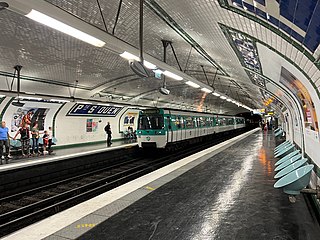
Porte de Saint-Ouen is a station on line 13 of the Paris Métro on the border of the 17th and 18th arrondissements. Unusually it has an escalator directly linking the platform to the street at the exit to the Rue Leibniz.

The Boulevard Saint-Germain is a major street in Paris on the Rive Gauche of the Seine.

The Boulevard de l'Hôpital is a tree-lined boulevard in the 13th arrondissement of Paris, which also briefly borders on the 5th arrondissement.

Hôpital de la Charité was a hospital in Paris founded by the Brothers Hospitallers of St. John of God in the 17th century. In 1935, it was closed and demolished to make way for the new faculty of medicine. Located at 45, rue des Saints-Pères, the premises currently house the Saints-Pères university centre, one of the sites of the Paris Cité University.

The Hôtel-Dieu is a public hospital located on the Île de la Cité in the 4th arrondissement of Paris, on the parvis of Notre-Dame. Tradition has it that the hospital was founded by Saint Landry in 651 AD, but the first official records date it to 829, making it the oldest in France and possibly the oldest continuously operating hospital in the world. The Hôtel-Dieu was the only hospital in the city until the beginning of the 17th century.
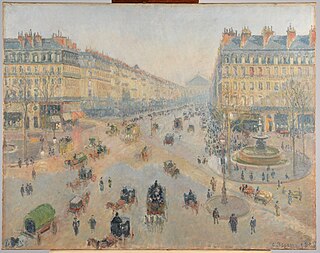
Haussmann's renovation of Paris was a vast public works programme commissioned by French Emperor Napoleon III and directed by his prefect of the Seine, Georges-Eugène Haussmann, between 1853 and 1870. It included the demolition of medieval neighbourhoods that were deemed overcrowded and unhealthy by officials at the time, the building of wide avenues, new parks and squares, the annexation of the suburbs surrounding Paris, and the construction of new sewers, fountains and aqueducts. Haussmann's work was met with fierce opposition, and he was dismissed by Napoleon III in 1870. Work on his projects continued until 1927. The street plan and distinctive appearance of the centre of Paris today are largely the result of Haussmann's renovation.
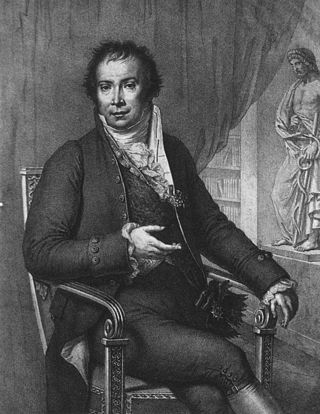
Jean-Louis Marie Alibert was a French dermatologist born in Villefranche-de-Rouergue, Aveyron. He was a pioneer of dermatology.

The Lyon tramway comprises eight lines, seven lines operated by TCL and one by Rhônexpress, in the city of Lyon, France. The original tramway network in Lyon was developed in 1879; the modern network started operation in 2001.
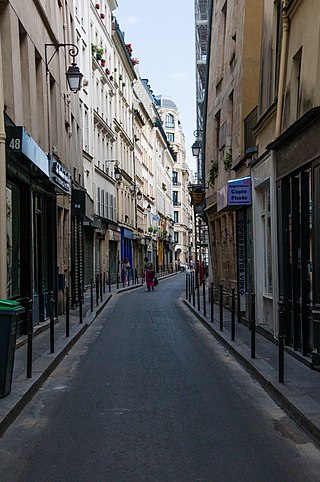
The Rue de Montmorency is a street in the historic Le Marais quarter of Paris, part of the city's 3rd arrondissement. It runs from the Rue du Temple to the Rue Saint-Martin.

Saint-Lazare Prison was a prison in the 10th arrondissement of Paris, France. It existed from 1793 until 1935 and was housed in a former motherhouse of the Vincentians.
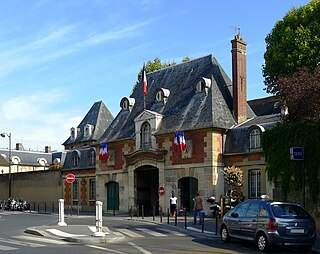
Hôpital Saint-Louis is a hospital in Paris, France. It was built in 1611 by architect Claude Vellefaux at the request of Henry IV of France. It is part of the Assistance publique - Hôpitaux de Paris hospital system, and it is located at 1 avenue Claude-Vellefaux, in the 10th arrondissement near the metro station Goncourt.
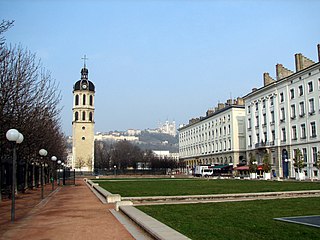
The Place Antonin-Poncet is a square located in the Bellecour quarter, near the Place Bellecour, in the 2nd arrondissement of Lyon, France. It is served by the metro station Bellecour of the lines A and D, and by many buses (10-12-14-15-29-30-35-53-58-88-99). The square belongs to the zone classified as World Heritage Site by UNESCO.

The Rue Duguesclin is a long street in Lyon crossing directly wholly the 6th and the 3rd arrondissement, and ends in the 7th arrondissement. This 2,800-meter street starts at the Boulevard des Belges and ends on the rue Rachais. The Lyon inhabitants and the telephone directory usually write the street name in a sole word (Duguesclin) and the cartographers do it in two words.
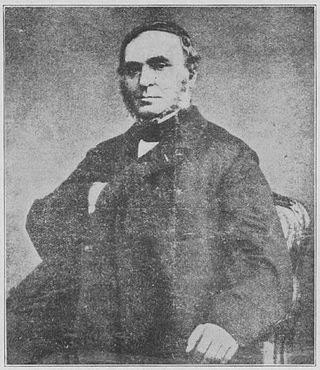
Pierre-Antoine-Ernest Bazin was a French physician and dermatologist born in Saint-Brice-sous-Forêt. His brother, Antoine-Pierre-Louis Bazin (1799-1863), was a noted Sinologist.

The Parvis Notre-Dame – Place Jean-Paul II is a city square in Paris, France. Located in the city's 4th arrondissement on the eastern half of the Île de la Cité, the square is bordered by the Hôtel-Dieu hospital to the north, the cathedral of Notre-Dame to the east, the Seine River to the south, and the Prefecture of Police headquarters to the west. The square contains France's point zéro marker, making it the very center of Paris for the purpose of measuring travel distance. Other points of interest include the Archaeological Crypt of the Île de la Cité and Charlemagne et ses Leudes, an equestrian statue of Charlemagne.
This article presents the main landmarks in the city of Paris within administrative limits, divided by its 20 arrondissements. Landmarks located in the suburbs of Paris, outside of its administrative limits, while within the metropolitan area are not included in this article.
Claude Vellefaux was a 16th/17th-century French architect, who had the Hôpital Saint-Louis built in 1611 at the request of Henry IV of France.

The Rue de l'Université is a street located in the 7th arrondissement of Paris, France.

